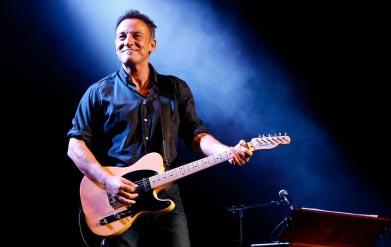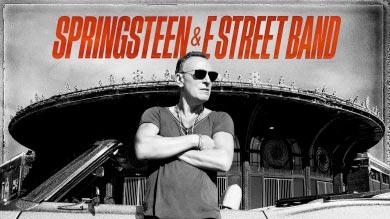
4 minute read
Bruce Springsteen Performs At Toyota Center February 14th
from Music News aka Houston Music News aka Texas Music NewsHouston's oldest music monthly. Now in our 4

classification — unfit for military service — freed him from having to go to Vietnam and allowed him to pursue music full time.
Advertisement
By the late 1960s, Springsteen was spending most of his time in Asbury Park on the New Jersey Shore, playing in several different bands while he forged his unique sound and introduced audiences to the gravelly baritone voice for which he would later become famous. It was there that he first met the musicians who would later form his E Street Band. Around this time, Springsteen also acquired his nickname, “The Boss,” because he had a habit of collecting money earned during shows and then distributing it evenly among his band mates.
After signing with Columbia Records, Springsteen released his first studio album in 1973. Greetings from Asbury Park, N.J. garnered critical acclaim but slow sales. Many compared him to Bob Dylan for his introspective lyrics and poetic style, but this did not immediately help Springsteen make it big. Springsteen and the E Street Band followed their debut with The Wild, The Innocent, & The E Street Shuffle later the same year, and again found themselves lauded by critics but largely dismissed by the public.
In 1975, after more than a year in the studio, Springsteen released a third album, Born to Run, which peaked at No. 3 on the Billboard 200 and skyrocketed him to fame. Drawing heavily on Springsteen’s New Jersey roots, the album offered soaring guitars, largerthan-life characters, urban romance and a rebellious spirit that captured the essence of the American Dream and connected with audiences of all ages.
Springsteen’s next album, Darkness on the Edge of Town, released in 1978, was a more somber affair, emphasizing themes of lost love, depression and existential suffering. “The whole force of Darkness was a survival thing,” he said. “After Born to Run, I had a reaction to my good fortune. With success, it felt like a lot of people who’d come before me lost some essential part of themselves. My greatest fear was that success was going to change or diminish that part of myself.”
To promote the album, Springsteen continued on next page
Bruce Springsteen
(continued from previous page) and the E Street Band embarked on a cross-country tour that would make them famous for their marathon performances (three or four hours per show), boisterous behavior and infectious energy, captivating audiences from California to New York. During this time, Springsteen also became famous for his integrity and pride as a performer, as stories of his exhausting performances and perfectionism in the recording studio became legendary.
Darkness at the Edge of Town marked a shift in Springsteen’s musical style that he continued in his next two albums, The River (1980) and Nebraska (1982), which both explored themes about working-class Americans. Nebraska was a raw, solo acoustic effort that has been lauded by music fans for its provocative sound. But Springsteen’s explosion into rock superstardom came in 1984 when he released Born in the U.S.A. With seven singles hitting the top of the Billboard Charts—including “Glory Days,” “Dancing in the Dark,” “Born in the U.S.A.” and “Cover Me” — the album would become one of the bestselling records of all time and spark a successful world tour.
Deeply affected by his conflicted love life and failed marriage to actress Julianne Phillips, Springsteen wrote and released Tunnel of Love in 1987. The album examined themes of love, loss, confusion and heartbreak, tracing the extreme highs and lows of relationships. As Dave Marsh from Creem magazine prophetically wrote in 1975, “Springsteen’s music is often strange because it has an almost traditional sense of beauty, an inkling of the awe you can feel when, say, first falling in love or finally discovering that the magic in the music is also in you. Which may also be first falling in love.”
Springsteen dissolved the E Street Band in 1989 and relocated with his new wife and family to California in the early 1990s. The albums he produced during this period — Human Touch and Lucky Town, released on the same day in 1992 — came from a happier place; ironically as his personal life improved, his songs seemed to lack the emotional intensity that had made him so famous in earlier years. He was criticized by his fans for

“going Hollywood” and no longer recording with the E Street Band. As happy as he may have been in his personal life, the early 1990s were not Springsteen’s glory days as an artist.
He began to bounce back with The Ghost of Tom Joad (1995), an acoustic set musically reminiscent of Nebraska and lyrically inspired by Pulitzer Prize–winning writers and books (John Steinbeck’s The Grapes of Wrath and Dale Maharidge’s Journey to Nowhere: The Saga of the New Underclass). Springsteen also recorded an Oscarwinning song, “The Streets of Philadelphia,” for the movie Philadelphia, starring Tom Hanks. In 1999, Springsteen reunited the E Street Band to tour in support of a new Greatest Hits album, selling out stadiums around the world despite his long absence from the limelight. It was the same year in which he was inducted into the Rock and Roll Hall of Fame.
In 2002, Springsteen and the E Street Band released their first studio album in 18 years, The Rising, which became both a critical and commercial success. Lyrically wrestling with the pain, anger and anguish caused by the September 11th terrorist attacks of 2001, the album restored Springsteen’s status as one of America’s most iconic musicians.

Later in the decade, Springsteen continued to experiment with different sounds. Devils & Dust (2005) was a bleak, sparse acoustic record in the vein of Nebraska and The Ghost of Tom Joad. We Shall Overcome: The Seeger continued on next page
Sessions (2006) was something completely different, a throwback jamboree of folksy Americana. Magic (2007) was a more traditional rock album incorporating the full E Street Band, a record viewed by many fans and critics as the true follow-up to The Rising.
Springsteen wrote the songs on Magic in something of a blue mood, discouraged by the Iraq War and declining health of E Street keyboardist and longtime friend Danny Federici, who died in April 2008. Just a few years later, Springsteen would mourn the death of fellow E-Street founding member and saxophonist Clarence Clemons, who died of complications from a stroke.
Continuing to thrive as a performer and songwriter, in 2012 Springsteen released the album Wrecking Ball, which, along with its single “We Take Care of Our Own,” was nominated for three Grammy Awards and fueled a highly successful tour. In 2014, Springsteen released High Hopes, his 18th studio album, which shot to the top of the U.S. and U.K. music charts. The High Hopes Tour followed and was considered to be a continuation of the record-breaking Wrecking Ball Tour. In April of that same year, the E-Street Band was inducted into the Rock Roll Hall of Fame.
Showing few signs of slowing down, in 2015 Springsteen celebrated the 35th anniversary of The River with a tour and a box set entitled The Ties That








